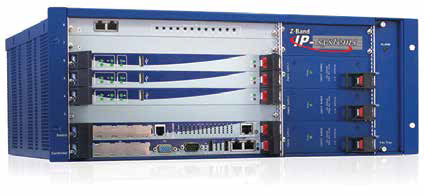Why is a Traditional RF Manufacturer Embracing IP?

Z-Band’s ZEN Master Premier offers an eight hot-swappable blade chassis. Carlisle, PA-based Z-Band has been recognized as the manufacturer of a video over twisted pair solution that is unique in the AV industry. That might seem to place them in competition with IPTV systems. However, Z-Band sees IPTV as a complementary solution.
That is why they’ve added a division that sells a high quality, fully capable IP video system. The ZEN series of encoders, decoders, transcoders and management modules form an IPTV and streaming method that can compete with any in the industry. Featuring low latency H.264 encoding, AES encryption and decoding by several means, this system should have broad appeal.
You can use nearly any source. Inputs to the encoders include DVI, HDMI, HD/SDI, 3G and composite video. The streams can be decoded by Z-Band decoders, set-top boxes at TVs, or any of the popular players.
Even the basic ZEN Classic encoder is network-friendly. You’ll have a choice of unicast or multicast with RTSP (Real-time Streaming Protocol) or mpeg-2 transport formats. Standard network protocols, like DHCP and NTP, are supported. This device only encodes a single stream. So, you’ll need one for each source or channel provided by your cable or satellite company. By moving up to a ZEN Premier encoder, you can support four input streams and maintain that network friendly set of transport methods.
The Z-Band Transcend Transcoder takes nearly any standard video input and provides an output in any of the popular adaptive bit-rate forms, Apple HLS, Adobe Flash, or Microsoft Silverlight. This will allow the videos to be accessible on PCs, notebooks, tablets and mobile devices.
The Z-Band system also includes content management capabilities. An Electronic Program Guide (EPG) allows scheduled programming and recording. The Video on Demand (VOD) and Network Digital Video Recorder (NDVR) capabilities will allow lectures to be stored and viewed when it is convenient for the student.
There are a few concerns with the Z-Band IP system. Maintenance costs are rather high. It can be expensive to go without a maintenance plan. The Z-Band system also compels the buyer to be dependent on the manufacturer for much of the system design and training in the use of the system.
A daily selection of features, industry news, and analysis for tech managers. Sign up below.
So, how does this new IP system position Z-Band in the market? They state that they now offer the best of both the RF and IP worlds. If your Ethernet network is already built, the IP system is a perfect fit. If not, the RF system can span campuses, whether small or very large, by mixing twisted pair and fiber and transmitting in RF format. An organization can use any Cat 5/6 568 compliant wiring structure to implement Z-Band’s RF system and can use off the shelf analog video components. This system makes it easy to do moves, adds, and changes when compared to coax based systems. Signal gain and tilt are automatically determined and introduced at the source to provide TV compliant signals at the destination. Want to move a TV from a patient’s room to a meeting room? The adjustments are automatic. A big advantage to the RF system is that it accomplishes the video delivery on compliant twisted pair network without becoming traffic on the corporate network. At the time at which it becomes beneficial to have the features of the IP world such as adaptive video, VOD, and NDVR installed, only the devices at the ends of the cabling need to be replaced. No cabling changes should be needed. And, cabling is where the majority of the expense in video systems often lies.
Phil Hippensteel, PhD, teaches information systems at Penn State Harrisburg.
